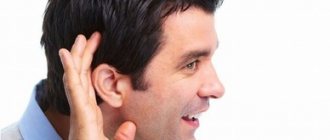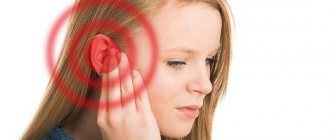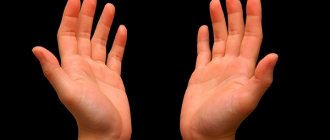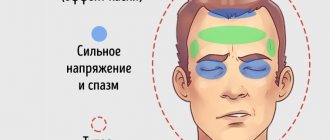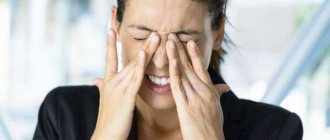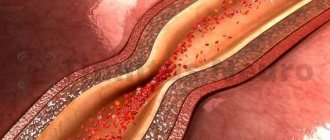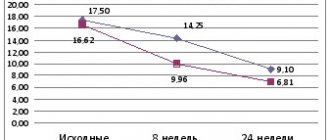Treatment of ARVI is a long process that takes from two to four weeks. But busyness at work and everyday activities do not allow some patients to complete the treatment to its final completion. A common consequence of colds is ear congestion, which has serious consequences for the body. For this reason, every person should know what to do if their ears become blocked after an acute respiratory viral infection and how to get rid of this unpleasant problem.
How does the feeling of fullness in the ears occur?
A feeling of fullness in the ears occurs when the eardrum, which separates the middle ear from the external auditory canal, experiences a difference in internal and external pressure. This occurs if the Eustachian tube, which connects the middle ear to the nasopharynx, does not open for some reason. A pressure difference also occurs when there is interference in the outer ear canal.
Causes
Congestion in the ears occurs due to pathological conditions of the ear, organs, tissues of the nasopharynx or as a result of everyday activities. Common causes of ear congestion:
- colds of the nasopharynx;
- accumulation of earwax;
- pressure changes during sudden ascent or descent;
- inflammation, fungal diseases of different parts of the ear;
- ingress of water when swimming;
- increased physical activity;
- the presence of a foreign body deep in the ear canal (small objects, insects);
- traumatic brain injury;
- cervical osteochondrosis;
- high blood pressure;
- allergic reaction;
- pregnancy;
- deviations in the structure of organs and body tissues;
- taking certain medications (Curantil).
Pathologies that can cause blocked ears
Often the causes of discomfort in the hearing organs are acute or chronic forms of disease, physiological abnormalities in the structure of the nasopharynx. Types of pathologies in which the ears are clogged:
- Infectious and inflammatory diseases of the auditory apparatus. Otitis externa occurs due to damage to the skin and walls of the ear canal by bacteria and pathogenic fungi. Acute catarrhal, esudative or purulent inflammation of the middle ear is caused by impaired ventilation of the internal cavity and the proliferation of infectious agents.
- Upper respiratory tract diseases: runny nose, colds, sore throat, sinusitis, pharyngitis. Inflammation of the mucous membranes, sinuses, and tonsils leads to the appearance of edema, which prevents free ventilation of the cavities.
- Allergic reactions of the mucous membranes of the nasopharynx to various substances entering the air. Swelling and mucus block the auditory tubes.
- Curvature of the cartilage and bone tissue of the skull. They interfere with normal ventilation of internal cavities and impede the outflow of mucus. The supply of air to the inner and middle ear is difficult.
- Attacks of hypertension. An increase in blood pressure leads to an increase in blood flow in the organs of the inner ear and vascular system, causing them to swell and complicating ventilation.
- Tumors, strokes, injuries , as a result of which the part of the brain responsible for auditory sensations was damaged.
- Otosclerosis and sensorineural hearing loss (Meniere's syndrome). They arise due to disturbances in the metabolic processes of the temporal lobe and inner ear.
- Damage to the nerve fibers of the temporomandibular joint. Occurs as a result of a bruise or dislocation of the lower jaw, leading to disruption of blood supply and nerve sensitivity.
- Osteochondrosis of the cervical spine. It disrupts blood supply and transmission of nerve impulses to the hearing organs.
The connection between blood pressure and ears
If a person excludes the occurrence of an otorhinolaryngological disease, then he begins to wonder at what pressure the ears become clogged.
Most often, this phenomenon is encountered by people with arterial hypertension, who have suffered a myocardial infarction or acute cerebrovascular accident.
The following conditions provoke pressure fluctuations:
- excess weight;
- low level of activity;
- injuries with blood loss;
- huge pressure;
- hereditary predisposition.
What to do if your ears are blocked
You can get rid of discomfort in the auditory organ on your own or with medical help. On their own they eliminate congestion caused by small wax plugs, mucus accumulation, pressure drops or water ingress.
If you have diseases of the ears, nasopharynx, deterioration of health (nausea, dizziness), itching, small objects or insects getting into the ear canal, you should consult an otolaryngologist.
How to relieve ear congestion at home
Articles on the topic
- Wax plug in the ear - how to dissolve it yourself at home using traditional medicine recipes
- Stomach ulcer - symptoms, signs and first manifestations of the disease
- Pancreatitis - diet, prohibited foods and sample menu for every day
The unpleasant sensation is eliminated independently in uncomplicated cases, in the absence of pain. At home, you need to free the ear canal from interference or equalize the internal pressure in the ear. To get rid of congestion, use the following methods:
- If wax has accumulated in the ears, 5-7 drops of hydrogen peroxide (3%) are dripped into the ear canal. After 10-15 minutes, tilt your head with your ear down so that the sour wax flows out, and rinse the ear canal with warm water. Another way to remove wax plugs: place the head on a pillow with the affected ear facing up, cover it with a napkin with a hole into which an ear candle is inserted and set on fire. When the candle burns out, the ear canal is cleaned with a cotton swab.
- A piece of cotton wool is moistened in camphor alcohol, applied to the ear, and held for 15-20 minutes. Warming is done 2-3 times a day until congestion is relieved.
- Add 3-4 drops of eucalyptus oil to an inhaler or container of hot water. The fumes are inhaled through the nose for 1-2 minutes, then the nasopharynx is cleared of mucus.
- Any moisture that gets into the ear canal after bathing is shaken out. If the left ear is injured, they tilt their head to the left and jump on the right leg; if the right ear is injured, it’s the other way around. Water can be extracted with a cotton ball - it is injected into the ear canal for five minutes until the liquid is absorbed. If the method does not help, lie on your side, place a warm heating pad under the sore ear, hold it for 15-20 minutes.
- If your ears are blocked due to pressure changes, pinch the wings of your nose and try to exhale into it with moderate force (Valsalva method). The method cannot be used for infectious diseases. To prevent congestion attacks, chew, swallow, or yawn. A light ear massage will help relieve pain.
- An insect that has crawled into the ear canal is removed by turning the affected ear upward and pouring a few drops of vegetable oil.
Drug treatment for ear congestion
Depending on the cause and stage of the disease, different forms of medications are used for external or internal use. If your ears are constantly blocked, the following types of medications are prescribed:
- Ear drops. They have anti-inflammatory, antibacterial, analgesic effects in acute and chronic otitis ( Auridexan, Otipax, Otofa, Sofradex ), dissolve and remove accumulations of earwax ( Remo-Vax, A-cerumen ).
- Tampons. Used for external otitis for disinfection (with boric alcohol), pain relief and reduction of inflammation (with camphor alcohol).
- Ointment. Used in the treatment of external inflammation of the ear to destroy infection and relieve pain ( Sofradex ).
- Nasal drops. Prescribed for infectious, inflammatory processes of the nasal cavity (vasoconstrictor drugs Xylometazoline, Naphazoline ).
- Pills. In cases of exacerbation of external, otitis media, and infectious diseases of the nasopharynx, medications with antibacterial ( Ampicillin, Ceftriaxone ), antiviral ( Oseltamivir ), and anti-inflammatory ( Nimesil, Indomethacin ) effects are prescribed. Antihistamines ( Cetirizine, Suprastin ) are used for allergic reactions.
Ear drops
Liquid medications are prescribed to cleanse the ear canals and treat ear diseases. Effect of using drops:
- softening, removal of wax accumulations from the ear canals;
- relieving inflammation, pain relief for various forms of otitis media;
- treatment of viral, bacterial and fungal ear infections.
Remedies for getting rid of sulfur plugs
Before use, the medicine for ear congestion must be warmed to body temperature. Lie with your ear up, instill the drug, wait, turn your head to the other side, let the solution flow out. Rinse the ear canal and dry it with a cotton swab. Medications for wax plugs:
- Remo-Wax. Drop 15-20 drops into the ear, hold for 10 minutes to half an hour, repeat up to 3-4 times a day.
- A-cerumen. Apply half a bottle (2 ml) per ear, hold for a minute. Treatment is carried out twice a day for 3-4 days.
Drugs for the treatment of otitis media
For inflammation of the middle and outer ear, single drugs with non-steroidal components or combined drugs with glucocorticoids are used.
Medicines relieve swelling, have an analgesic effect, and are contraindicated for use if the eardrum is damaged.
For the treatment of otitis using:
- Otipax. Contains the anti-inflammatory component phenazone and the anesthetic lidocaine. Apply 2-3 times/day, 4 drops. The recommended course of treatment is up to 10 days.
- Otinum. The active substance is choline salicylate. Drop 3-4 drops into the ear three to four times a day. Duration of use – up to 10 days.
- Sofradex. The active components are the antibiotics framycetin, gramicidin, and the anti-inflammatory hormone dexamethasone. Instill 2-3 drops 3-4 times a day. The average duration of treatment is up to 7 days.
Antibacterial drops for stuffy ears
The following drugs are prescribed for the treatment of acute and chronic otitis media caused by bacterial and fungal infections:
- Otofa. Drug with rifampicin sodium. Drop into the ear canal 2-3 times a day for a week: adults - five drops, children - three.
- Candibiotic. Contains chloramphenicol, clotrimazole, lidocaine. Apply 3-5 drops 3 to 5 times/day for a week.
- Auridexan. A drug based on decamethoxin. Adults and children over 12 years of age are prescribed 2-3 drops 3-4 times a day, the duration of the course is determined by the doctor.
Otitis
Otitis is the definition of all inflammatory ear diseases.
Reasons for the development of the disease
Otitis develops for the following reasons:
- Penetration of pathogens of bacterial and viral infections into the ear through the external auditory canal
- Sudden changes in pressure (barotrauma) that occur during diving or mountaineering
- Mechanical damage
Clinical manifestations of otitis media
Ear inflammation can be external, middle and internal.
External otitis is manifested by inflammatory changes in the skin and subcutaneous tissue of the external auditory canal. This may be a boil or a diffuse external inflammatory process.
Otitis media - ear congestion, hearing loss, increased body temperature and pain, leakage of fluid from the external auditory canal. If left untreated, the exudate becomes thick and adhesions may form, which can further lead to permanent hearing loss.
Internal otitis is accompanied by dizziness, which is associated with the development of persistent hearing loss and tinnitus.
Treatment of the disease
Therapy for otitis should be comprehensive and depends on the degree of development of the disease and the area of the lesion. Only an ENT doctor, therapist or general practitioner can prescribe treatment. Complex therapy includes antibacterial, decongestant, antipyretic, local anesthetic and anti-inflammatory drugs, and physiotherapeutic procedures.
Traditional medicine methods for ear congestion
Non-traditional recipes can be used if the ear is periodically blocked in the absence of inflammatory processes in the nasopharynx. You must first consult with your doctor. Traditional medicine:
- Fresh aloe juice: for otitis media, drop 2-3 drops, for external otitis, moisten a tampon, make a compress for 20-30 minutes in the morning and evening.
- To 100 ml of alcohol (70%) add 30 g of crushed propolis. The container with the mixture is tightly closed, placed in a warm place, left for a week, shaking regularly. The finished alcohol tincture is filtered, a cotton swab is moistened with it, and placed in the ear canal. Treatment is carried out twice a day for 2-3 weeks.
- A slightly crushed, rolled-up geranium leaf is inserted into the ear canal. Keep for 1-2 days.
- Onion juice. To remove ear plugs, mix with warm boiled water (1:1) or vodka, boric acid (1:4). Apply 3-4 drops twice a day, keep for about 5-10 minutes.
- Sunflower, almond or olive oils are used to cleanse ear wax. Drop 10 drops twice a day. Duration of treatment is 2-3 days.
Prevention
Hygienic, hardening, and protective measures improve health and prevent the development of diseases.
As a result, the risk of ear congestion due to disease or adverse environmental factors is significantly reduced.
Preventive actions:
- Clean the ear canals with ear sticks in a timely manner.
- Regularly clear the nasopharynx of mucus accumulations. Rinse the nasal passages with saline solution - 1-2 teaspoons of salt per glass of warm water - using a pipette, microenemas 2-3 times a day.
- Use earplugs while swimming, dry your ear canals after water procedures.
- Protect ears from wind and cold.
- At the first symptoms of colds, start treatment.
- Avoid contact with substances and products that cause allergies.
Causes of congestion
There are factors that contribute to the development of ear congestion. In most cases, they “accompany” each other. The main ones are listed below:
- acute form of otitis media;
- acute inflammatory process in the Eustachian tube;
- the presence of sulfur plugs;
- foreign bodies in the ear (eg insects);
- rhinitis;
- getting water into your ears (during swimming, diving, etc.);
- deviated nasal septum;
- long-term use of certain groups of pharmacological drugs;
- swelling of the auditory tube (for example, during landing or takeoff of an airplane, during deep diving).

